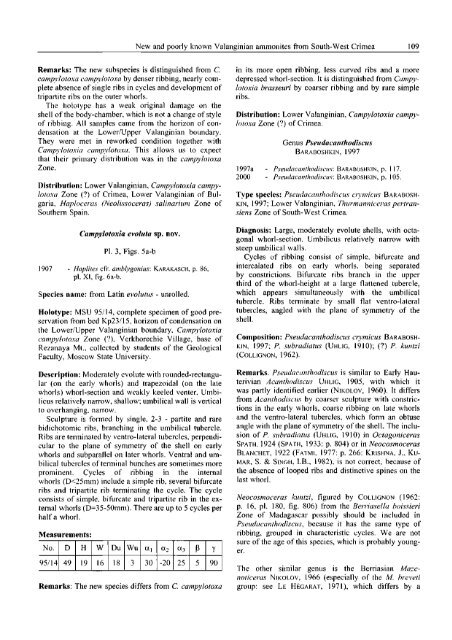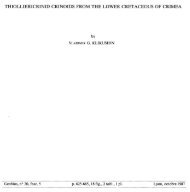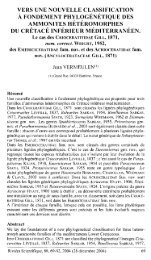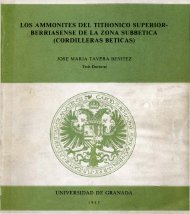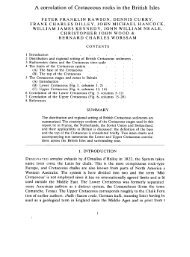108 Evgenij J. BARABOSHKIN & Irina A. MIKHAILOVAp. 531, pi. I, fig. 1, reproduced in VASICEK., 1994:p. 180. pi. 1, fig. 1). is distinguished <strong>from</strong> Campylotoxiacampylotoxa by more frequent ribbing, weakenedin the middle of whorls <strong>and</strong> is similar toTeschenites neocomiensefortnis HQHENEGGER in UHLIG,1902.Busnardoites campylotoxus (COMPANY, 1987: p. 145,pi. 11, fig. 12, 13; pi, 19, fig, 13) is referred by us tothe new subspecies Campylotoxia densocostata, describedbelow.Neocomites sp. (KEMPER, 1976: pi. 30. fig. 10), redefinedlater as Thurmanniceras cf. campylotoxum (KEMPER et ah1981: p. 279), has bidichotomic ribs with high branchingas in Teschenites.Hoplites ambligonium (TZANKOV, 1946: pi. XI, fig. 10) isclose to Campylotoxia campylotoxa by the type of cyclicityof its ribs, but its poor preservation does not allow acomplete identification.It seems that only one sample of Busnardoites campylotoxusfigured by FARAONI et al. (1997: pi. 6, tig. 3) hasribbing close to the real Campylotoxia campylotoxa.The other specimens (pi, 6. fig. 1 <strong>and</strong> 2) are closer toThurmanniceras, because they have a very high pointof rib-branching. The record of C. campylotoxa <strong>from</strong>the Saynoceras verrucosum Zone, is doubtful in theabsence of that species in the lower Upper <strong>Valanginian</strong>.We think that the sections, described by FARAONI et al.(1997) are characterised by the earliest appearance ofSaynoceras verrucosum <strong>and</strong> thus of early Late <strong>Valanginian</strong>age.Neocomites teschenensis, figured by ETTACHFINI et al.(1998: fig. 2G) is very similar to Campylotoxia campylotoxa,having the same style of ribbing, bipartite in theinner whorls. Unfortunately the other parts of the sampleare not well-preserved <strong>and</strong> complete identification isdifficult.Similar to Campylotoxia campylotoxa is C. brasseuri(COLLIGNON). which differs by the prevalence ofsingle ribs <strong>and</strong> by bifurcate tripartite ribs at the end ofeach cycle of ribbing. Its cycles of ribbing consist oftwo to four single, one bipartite, <strong>and</strong> one bifurcatetripartite rib, as is apparent in the type of Sarasinellabrasseuri, COLLIGNON, 1962: p. 26, fig. 832). The presenceof bipartite ribs with a high point of branchingindicates similarity of this species with the genus Thurmanniceras.Distribution. Lower <strong>Valanginian</strong>, Campylotoxia campylotoxaZone of Crimea, France, Slovakia, Bulgaria, Pakistan,Morocco; Haploceras (Neolissoceras) salinariumZone of Spain, (?) Upper <strong>Valanginian</strong> Saynoceras verrucosumZone of Italy.Campylotoxia campylotoxa densocostata subsp. nov,PI. 2, Fig. 7; PI. 3, Figs, la-b, Text-fig. 9, 111934 - Hoplites amblygonimn: STEFANOV, p. 218, pi. VII,fig. I (only).1987 - Busnardoites campylotoxus: COMPANY, p. 145.pi. 11. fig. 12, 13; pi. 19. fig. 13.Subspecies name: <strong>from</strong> Latin densuscostatus - ribbed.- frequent <strong>and</strong>Holotype: MSU 95/12 a complete specimen of goodpreservation <strong>from</strong> bed Kp23/I5, condensed horizon onthe Lower/Upper <strong>Valanginian</strong> boundary, Campylotoxiacampylotoxa Zone (?) of Verkhorechie Village, base ofRezanaya Mt.Paratypes: several fragments of satisfactory preservation<strong>from</strong> the same locality collected by students of the GeologicalFaculty. Moscow State University.Description: Moderate, with high trapezoidal whorl-section<strong>and</strong> weakly keeled venter. Umbilicus relatively narrow,shallow; umbilical wall is vertical to projected,narrow.Sculpture consists of rare simple ribs, 3-4 - partite<strong>and</strong> bidichotomic rib, branching at an umbilical tubercle.Ribs terminate by ventro-latcral tubercles, whichbecome subparallel to the plane of symmetry of theshell in adult. Cycles of ribbing are separated byweak constrictions <strong>and</strong> not very typical for the genus,because single ribs are presented in internal whorlsonly. Cycles of internal whorls (lX20mm) begin by asimple or bifurcate rib <strong>and</strong> include also 2-3 bifurcateribs <strong>and</strong> a tripartite rib terminating the cycle. Cyclesof the external whorls (D=20-40mm) each consist ofa bifurcate rib <strong>and</strong> tripartite rib. There are up to 9cycles per whorl. The cyclicity disappears later(D>50mm) <strong>and</strong> the ribbing then consists of tripartitebidichotomic ribs with additional branching on one ofthe branches.Measurements:No. D H W Du Wu ai 0.2 P y95/12 52 21,5 15,5 16 3 30 -10 10-15 15 -5; 9095/13 - 20 14 3 30 -15 15 15 90Suture line (Figure 9): Ventral lobe (V) is narrow, deep<strong>and</strong> bifurcate: umbilical lobe (U) is tripartite, somewhatasymmetric, strongly deviating inside umbilicus; the firstumbilical lobe (U ) is twice shorter than the umbilicallobe (U).External (V/U) <strong>and</strong> first lateral (U/U 1 ) saddles areasymmetric, but the former is broader <strong>and</strong> somewhatshallower than the latter.
<strong>New</strong> <strong>and</strong> <strong>poorly</strong> <strong>known</strong> <strong>Valanginian</strong> <strong>ammonites</strong> <strong>from</strong> <strong>South</strong>-<strong>West</strong> Crimea 109Remarks: The new subspecies is distinguished <strong>from</strong> C.campylotoxa campylotoxa by denser ribbing, nearly completeabsence of single ribs in cycles <strong>and</strong> development oftripartite ribs on the outer whorls.The holotype has a weak original damage on theshell of the body-chamber, which is not a change of styleof ribbing. All samples came <strong>from</strong> the horizon of condensationat the Lower/Upper <strong>Valanginian</strong> boundary.They were met in reworked condition together withCampylotoxia campylotoxa. This allows us to expectthat their primary distribution was in the campylotoxaZone.Distribution: Lower <strong>Valanginian</strong>, Campylotoxia campylotoxaZone (?) of Crimea, Lower <strong>Valanginian</strong> of Bulgaria,Haploceras (Neoiissoceras) sallnarrum Zone of<strong>South</strong>ern Spain.Campylotoxiaevoluta sp. nov.PL 3, Figs. 5a-b1907 - Hoplites cfr. amblygonius: KARAKASCH, p. 86,pi. XI, fig. 6a-b.Species name: <strong>from</strong> Latin evolutus - unrolled.Holotype: MSU 95/14, complete specimen of good preservation<strong>from</strong> bed Kp23/15, horizon of condensation onthe Lower/Upper <strong>Valanginian</strong> boundary, Campylotoxiacampylotoxa Zone (?), Verkhorechie Village, base ofRezanaya Ml., collected by students of the GeologicalFaculty, Moscow State University.Description: Moderately evolute with rounded-rectangular(on the early whorls) <strong>and</strong> trapezoidal (on the latewhorls) whorl-section <strong>and</strong> weakly keeled venter. Umbilicusrelatively narrow, shallow; umbilical wall is verticalto overhanging, narrow.Sculpture is formed by single, 2-3 - partite <strong>and</strong> rarebidichotomic ribs, branching in the umbilical tubercle.Ribs are terminated by ventro-lateral tubercles, perpendicularto the plane of symmetry of the shell on earlywhorls <strong>and</strong> subparallel on later whorls. Ventral <strong>and</strong> umbilicaltubercles of terminal bunches are sometimes moreprominent. Cycles of ribbing in the internalwhorls (D


